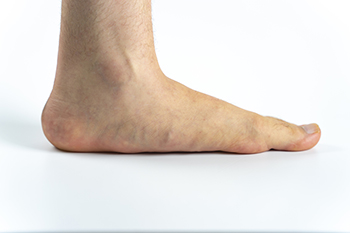Items filtered by date: January 2022
What Causes Adult-Onset Flat Feet?
It is not unusual for adults to develop flat feet as they age, even though they never had the problem before. Although this condition often affects only one foot, it sometimes occurs in both. Its main cause is changes to the posterior tibial tendon that limit its ability to lift the arch of your foot. Unfortunately, this dysfunction is progressive and usually worsens if not treated. Overuse of the tendon by walking, running, hiking or climbing stairs, is often the main cause. You may start to experience pain, swelling, a flattening of the arch and an inward rolling of your ankle. Eventually, the pain will increase, accompanied by swelling and redness. In the worst cases arthritis may develop. Several non-surgical treatments are available, including braces, orthotics, wearing a cast, and taking medication. In some cases surgery may be required. If you think you may be developing flat feet, it is suggested that you consult a podiatrist at your earliest convenience for a complete examination and to discuss appropriate treatment options.
Flatfoot is a condition many people suffer from. If you have flat feet, contact Afsaneh Latifi, DPM from Lenox Hill Podiatry. Our doctor will treat your foot and ankle needs.
What Are Flat Feet?
Flatfoot is a condition in which the arch of the foot is depressed and the sole of the foot is almost completely in contact with the ground. About 20-30% of the population generally has flat feet because their arches never formed during growth.
Conditions & Problems:
Having flat feet makes it difficult to run or walk because of the stress placed on the ankles.
Alignment – The general alignment of your legs can be disrupted, because the ankles move inward which can cause major discomfort.
Knees – If you have complications with your knees, flat feet can be a contributor to arthritis in that area.
Symptoms
- Pain around the heel or arch area
- Trouble standing on the tip toe
- Swelling around the inside of the ankle
- Flat look to one or both feet
- Having your shoes feel uneven when worn
Treatment
If you are experiencing pain and stress on the foot you may weaken the posterior tibial tendon, which runs around the inside of the ankle.
If you have any questions please feel free to contact our office located in New York, NY . We offer the newest diagnostic and treatment technologies for all your foot and ankle needs.
Ways to Treat Your Feet With Care as You Age
Sometimes we tend to take our feet for granted. But as we get older, the need for proper foot care increases, especially as it becomes more difficult to reach the feet and toes. Fortunately, there are a number of ways to give your feet the attention they so well deserve. One way is to soak your feet in Epsom salts for about 10 minutes. Dry them thoroughly, especially between the toes. Next, treat your feet to lotion or cream to keep them from drying out and cracking, as that may lead to sores and infection. Keep the toenails trimmed straight across to avoid the formation of ingrown toenails, which can be painful and possibly become infected. Wear comfortable and stable shoes that have non-slip soles and provide good support. Be sure to examine your toes and feet often and look for any changes to the skin, such as blisters, corns or calluses. Most importantly, if you experience pain in the feet or toes, be sure to make an appointment with a podiatrist for a full examination and possible treatment options.
Proper foot care is something many older adults forget to consider. If you have any concerns about your feet and ankles, contact Afsaneh Latifi, DPM from Lenox Hill Podiatry. Our doctor can provide the care you need to keep you pain-free and on your feet.
The Elderly and Their Feet
As we age we start to notice many changes in our body, but the elder population may not notice them right away. Medical conditions may prevent the elderly to take notice of their foot health right away. Poor vision is a lead contributor to not taking action for the elderly.
Common Conditions
- Neuropathy – can reduce feeling in the feet and can hide many life-threatening medical conditions.
- Reduced flexibility – prevents the ability of proper toenail trimming, and foot cleaning. If left untreated, it may lead to further medical issues.
- Foot sores – amongst the older population can be serious before they are discovered. Some of the problematic conditions they may face are:
- Gouging toenails affecting nearby toe
- Shoes that don’t fit properly
- Pressure sores
- Loss of circulation in legs & feet
- Edema & swelling of feet and ankles
Susceptible Infections
Diabetes and poor circulation can cause general loss of sensitivity over the years, turning a simple cut into a serious issue.
If you have any questions please feel free to contact our office located in New York, NY . We offer the newest diagnostic and treatment technologies for all your foot and ankle needs.
See Your Podiatrist Regularly If You Work On Your Feet
Do Your Hiking Shoes Fit Correctly?
 Having shoes that fit correctly when hiking is very important because of the stress that is put on your feet. It is important to make sure that the hiking shoes are snug, but not too tight, and that the toes have room to wiggle. There are a few things that can be done in order to make sure hiking boots fit correctly when purchasing them. Because your feet tend to swell during the day, it’s a good idea to try on shoes either toward the end of the day or right after you exercise. Wearing the same socks and orthotics that will be worn with the shoes while hiking is also key in order to make sure you understand how the shoes will fit under those conditions. Shoes should also have a proper width to give the toes enough space, and there should also be enough space between the edge of the toes and the edge of the shoe. If you are unsure that your shoes fit properly, it’s suggested that you consult with a podiatrist who can examine your feet and offer expert advice.
Having shoes that fit correctly when hiking is very important because of the stress that is put on your feet. It is important to make sure that the hiking shoes are snug, but not too tight, and that the toes have room to wiggle. There are a few things that can be done in order to make sure hiking boots fit correctly when purchasing them. Because your feet tend to swell during the day, it’s a good idea to try on shoes either toward the end of the day or right after you exercise. Wearing the same socks and orthotics that will be worn with the shoes while hiking is also key in order to make sure you understand how the shoes will fit under those conditions. Shoes should also have a proper width to give the toes enough space, and there should also be enough space between the edge of the toes and the edge of the shoe. If you are unsure that your shoes fit properly, it’s suggested that you consult with a podiatrist who can examine your feet and offer expert advice.
Finding a properly-fitting shoe is important in reducing injuries and preventing foot problems. For more information about treatment, contact Afsaneh Latifi, DPM from Lenox Hill Podiatry. Our doctor will treat your foot and ankle needs.
Proper Shoe Fitting
A common concern when it comes to foot health, having properly fitted shoes can help prevent injuries to the foot. Out feet affect our posture and gait, which in turn affects the biomechanics and overall bodily structure. With 33 joints, 26 bones, and over 100 ligaments, the potential for serious injury is much greater than one realizes. Although the feet cease growth in adulthood, they still change shape as they mature. Here are some factors to consider when it comes to investing in proper fitting shoes:
- Be sure the shoes fit correctly right away
- Ensure the ball of your foot fits comfortably in the widest portion of the shoes
- Even though they may look fashionable, improper fitting shoes can either create adverse conditions or exacerbate existing ones you may already have
- Walk along a carpeted surface to ensure the shoes comfortably fit during normal activity
Keeping in mind how shoes fit the biomechanics of your body, properly-fitting shoes are vitally important. Fortunately, it is not difficult to acquire footwear that fits correctly. Be sure to wear shoes that support the overall structure of your body. Do your feet a favor and invest in several pairs of well-fitted shoes today.
If you have any questions please feel free to contact our office located in New York, NY . We offer the newest diagnostic and treatment technologies for all your foot and ankle needs.
The Many Possible Causes of Ankle Pain
Ankle discomfort can manifest as pain, stiffness, swelling, bruising, redness, tingling, or an inability to put weight on the ankle. There are several possible causes of ankle pain with the most common being sprains and strains of the ankle’s ligaments, and fractures of one or more bones in the ankle. Achilles tendon ruptures are another possible cause of ankle pain. They can occur when the Achilles tendon tears away from the heel bone which can cause swelling, bruising, and pain in the ankle. Rheumatoid arthritis, where the body’s immune system attacks the lining on the inside of the joint capsule, can occur in the ankle joint and be quite painful. Another form of arthritis—gout—causes a painful buildup of hardened uric acid crystals to deposit on joints, which can occur not only in the big toe, but the ankle joint as well. A bacterial infection (sometimes referred to as septic arthritis) may also set in the ankle joint, causing cartilage and bone damage, and pain. It is highly suggested that you seek the care of a podiatrist to determine the source and receive treatment for any ankle pain or discomfort you may be experiencing.
Ankle pain can have many different causes and the pain may potentially be serious. If you have ankle pain, consult with Afsaneh Latifi, DPM from Lenox Hill Podiatry. Our doctor will assess your condition and provide you with quality foot and ankle treatment.
Ankle pain is any condition that causes pain in the ankle. Due to the fact that the ankle consists of tendons, muscles, bones, and ligaments, ankle pain can come from a number of different conditions.
Causes
The most common causes of ankle pain include:
- Types of arthritis (rheumatoid, osteoarthritis, and gout)
- Ankle sprains
- Broken ankles
- Achilles tendinitis
- Achilles tendon rupture
- Stress fractures
- Tarsal tunnel syndrome
- Plantar fasciitis
Symptoms
Symptoms of ankle injury vary based upon the condition. Pain may include general pain and discomfort, swelling, aching, redness, bruising, burning or stabbing sensations, and/or loss of sensation.
Diagnosis
Due to the wide variety of potential causes of ankle pain, podiatrists will utilize a number of different methods to properly diagnose ankle pain. This can include asking for personal and family medical histories and of any recent injuries. Further diagnosis may include sensation tests, a physical examination, and potentially x-rays or other imaging tests.
Treatment
Just as the range of causes varies widely, so do treatments. Some more common treatments are rest, ice packs, keeping pressure off the foot, orthotics and braces, medication for inflammation and pain, and surgery.
If you have any questions, please feel free to contact our office located in New York, NY . We offer the newest diagnostic and treatment technologies for all your foot care needs.








